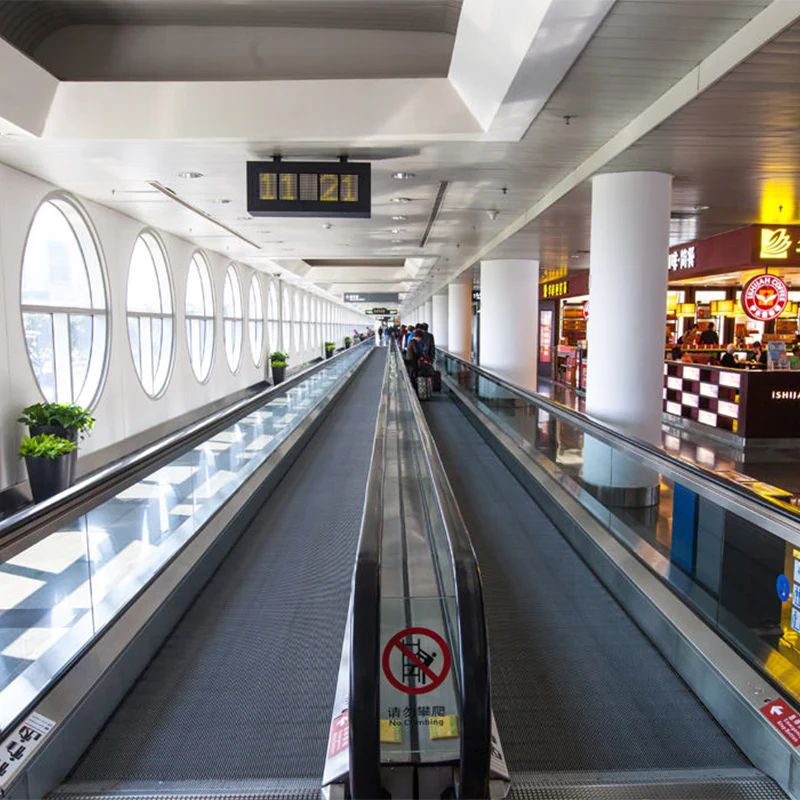Benefits and Applications of Horizontal Autowalks
2024-07-18
A horizontal autowalk, also known as a moving walkway, travelator, or moving sidewalk, is a conveyance system that transports people horizontally or along a slight incline. They are commonly found in airports, transit stations, and large commercial buildings. Here are the key features, benefits, and applications of horizontal autowalks:
Key Features:
1. Conveyance System:
- Continuous Belt: Made of metal, rubber, or other durable materials.
- Moving Handrails: Usually provided for passenger support and stability.
2. Speed:
- Standard Speed: Typically between 0.4 to 0.8 meters per second (1.3 to 2.6 feet per second).
- Variable Speed: Some models may have variable speeds or accelerators to increase efficiency.
3. Length and Width:
- Customizable: Available in various lengths to suit the specific needs of a location.
- Width: Designed to accommodate one or more passengers side by side, usually around 1-1.2 meters (3.3-4 feet) wide.
4. Incline:
- Horizontal: Primarily used for flat or nearly flat surfaces.
- Inclined: Slightly inclined models are available for small changes in elevation.
5. Safety Features:
- Emergency Stop Buttons: Located at intervals along the walkway.
- Safety Sensors: Detect obstacles and ensure passenger safety.
- Anti-Slip Surface: Ensures traction for passengers.
6. Construction Materials:
- Durable Materials: Built to withstand heavy use and harsh environments.
- Weather Resistant: Models designed for outdoor use are resistant to weather elements.
Benefits:
1. Convenience:
- Ease of Movement: Facilitates the movement of people over long distances without walking.
- Accessibility: Assists people with mobility issues, carrying luggage, or with strollers.
2. Efficiency:
- Time-Saving: Reduces the time needed to traverse large spaces, such as airport terminals.
- Flow Management: Improves the flow of pedestrian traffic, reducing congestion.
3. Energy Efficient:
- Lower Energy Consumption: Compared to elevators or escalators for horizontal transport.
4. Space Utilization:
- Compact Installation: Maximizes the use of available space in large facilities.
Applications:
1. Airports:
- Terminals: Connecting different parts of terminals, including gates, baggage claim, and check-in areas.
- Transfer Hubs: Efficiently moving passengers between different terminal sections.
2. Transit Stations:
- Subway and Train Stations: Assisting passengers in moving between platforms and exits.
- Intermodal Hubs: Facilitating smooth transitions between different modes of transport.
3. Commercial Buildings:
- Shopping Malls: Providing easy access to different sections and floors.
- Exhibition Centers: Moving visitors between exhibition halls and facilities.
4. Hospitals:
- Large Hospitals: Assisting in the movement of patients, visitors, and staff across large campuses.
5. Theme Parks and Resorts:
- Parks: Helping visitors move between different attractions and facilities.
- Resorts: Providing easy access to various amenities and sections of the resort.
6. Industrial Facilities:
- Factories and Warehouses: Facilitating the movement of workers and equipment across large areas.
7. Public Spaces:
- Urban Areas: Integrating into public spaces to improve pedestrian movement and connectivity.
- Parks and Recreational Areas: Assisting visitors in moving across large parks or recreational areas.
Horizontal autowalks enhance accessibility, efficiency, and convenience in various settings, making them valuable assets in modern infrastructure.



